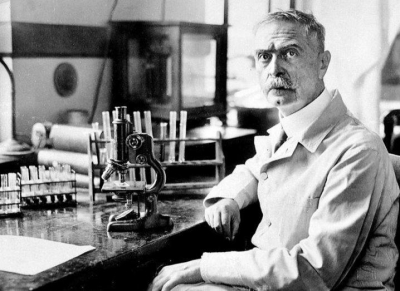
In 1908, as the head of the pathology department at the Imperial Wilhelminen Hospital in Vienna, Landsteiner showed that polio is a viral disease. Together with his assistant Erwin Popper, Landsteiner conducted an autopsy of a boy who had died of polio. To determine whether bacteria or a different agent had caused the polio, Landsteiner collected some of the boy’s spinal fluid and strained it through a filter fine enough to trap bacteria. He then cultured this filtered particles and found that no bacteria grew there. To determine if the infected spinal fluid material was infectious, Landsteiner injected it into rabbits, mice, and guinea pigs, but none of the animals became sick. Landsteiner and Popper injected the filtered spinal fluid into two Old World rhesus monkeys (http://eol.org/pages/327960/overviewMacaca mulatta), and they found that both died within two weeks. Landsteiner performed autopsies on the rhesus monkeys that revealed spinal cord lesions like those observed in human polio victims. Because Landsteiner and Popper had eliminated bacteria as a potential cause of the infection earlier in the experiment, they concluded that a virus must have caused the infection. Landsteiner proposed that it could be possible to create a polio vaccine. However, it took forty-seven years until Jonas Salk at the University of Pittsburgh School of Medicine in Pittsburgh, Pennsylvania, developed and successfully administered the polio vaccine in 1952.
During World War I, Landsteiner performed blood transfusions on many injured soldiers. In 1916 and at the age of forty-eight, Landsteiner met and married Leopoldine Helene Wlatso. A year later, they had to their only child, Ernst. Because of economic difficulties in post-war Austria, Landsteiner and his family moved to Netherlands in 1919. Landsteiner soon obtained a job at the Catholic R.K. Hospital in The Hauge, Netherlands, performing routine tests on urine and blood. During his stay in the Netherlands, he published twelve papers about immune responses triggered by changes in small fat or sugar molecules.
In 1923, the Rockefeller Institute for Medical Research in New York City, New York, offered Landsteiner a position to research immunity and allergies. Landsteiner accepted and moved with his family to the US. Most biographers report that Landsteiner’s move to the US was very difficult for him. He disliked the fame that came with his status as an authority on immunology and avoided invitations to speak publicly, preferring instead to stay in his laboratory. Landsteiner became a US citizen in 1929, and he won the Nobel Prize in Physiology or Medicine in 1930.
Credit : The Embryo Project
Picture Credit : Google




